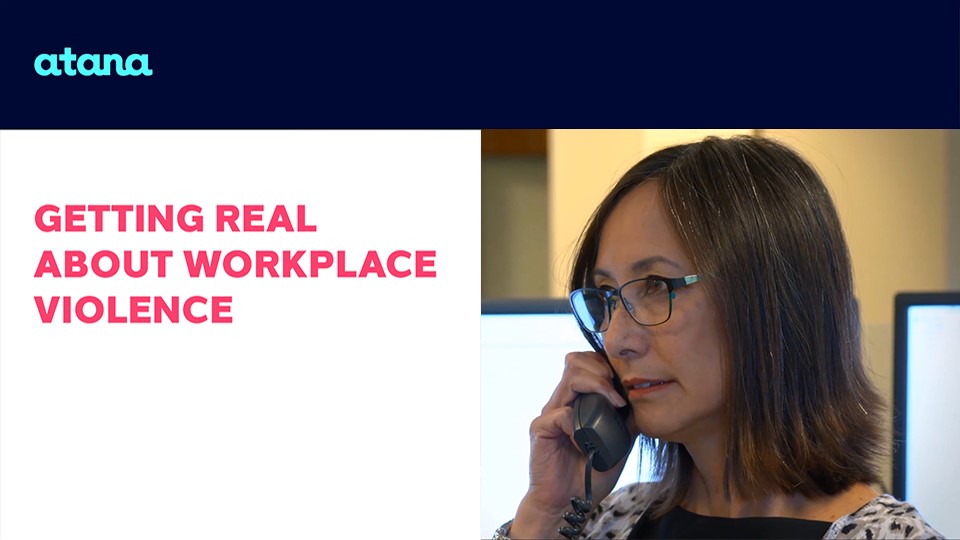
None of us wants to think that our workplace might be the scene of intimidation, threatening behavior, or even something as dangerous as an active shooter. But preparing for the unthinkable is the best way to empower both ourselves and our employees with the know-how needed to constructively respond to extreme violence ...wherever or however that might happen.
Workplace Violence Training Raises Questions
As an HR or L&D professional responsible for training employees in your organization, you know that the topic of workplace violence can be complex and potentially intimidating; and it can generate questions that may be challenging to answer.
In addition to covering workplace violence awareness and prevention, Atana's training also helps people think about how to respond if an act of extreme violence should occur— helping develop the mental preparation to do so quickly and effectively. Ensuring employees are informed, ready, and confident in this area are the core goals of our best-selling program Getting Real About Workplace Violence.
To help you answer the questions most likely to arise in response to workplace violence prevention and response training—and especially as related to incidents of extreme violence (such as an active shooter)—Atana consulted James Sporleder.
A security industry veteran and subject matter expert in workplace violence, Sporleder is the training program host and content developer behind Getting Real About Workplace Violence. In his nearly 30 years of training military personnel, employees of the U.S. government, and fortune 500 business workforces, he’s heard it all. And he has the answers you need to respond effectively when your training covers extreme violence response and related active shooter situations; topics that may be uncomfortable for employees and for you as a training facilitator or sponsor.
Answering Employees' 5 Most-Asked Questions About Extreme Workplace Violence Response Training
1. Your employee asks: “Why do we have to take this training?”
Your answer: Our organization believes that the safety and security of our people and our workplace is a #1 priority. You shouldn’t have to spend your workdays thinking about your personal security, and we’ve taken proactive steps to help make this a safe place to work.
We’ve all seen the news reports about tragic incidents of extreme violence happening in workplaces and public spaces across our country. More than 2 million U.S. workers are victims of violence at work every year, and shootings now account for three-quarters of workplace homicides.
Therefore, our initial emphasis is on awareness and prevention. We believe it’s important to address the possibility of workplace violence directly by helping you learn to spot early signs that can indicate someone might be considering violent action. And in the unlikely event that an act of extreme violence does occur in our organization—or wherever you happen to be for that matter--we want you to know what to do to get and stay safe.
Those are our fundamental goals with this training— in effect, helping you to be mindful, not fearful.
2. Your employee asks: “Are you doing this extreme violence response training because you’ve received some kind of threat against our organization?”
Your answer: That’s a very good question, and I’m glad to tell you the answer is NO.* We have not received any direct or overt threats against our organization.
The fact is, we genuinely care about the safety and security of our employees, and we’re committed to doing everything within our power to help you stay safe—not only here at work, but anywhere else you might be.
We’re conducting this training to empower you, to help you build awareness and knowledge so you can play a strong and confident role in creating a safe work environment. And if the unthinkable should happen, here or elsewhere, we want you to be informed and ready to protect yourself.
*Note: If your organization has received threatening information, you will need to handle this question differently. Be sure to coordinate with the appropriate offices for an integrated and comprehensive response.
3. Your employee asks: “How do you know that the guidance provided by this training is sound?”
Your answer: Our organization has chosen a top-quality training program from Atana, a trusted and award-winning leader in organizational learning and development for more than 30 years.
To develop this training, Getting Real About Workplace Violence, Atana teamed with subject matter expert James Sporleder and Regulus Media, a respected training solutions developer chosen by the FBI and the U.S. Department of Homeland Security for active shooter response guidance.
The training course you'll be taking also aligns with the American National Standard on Workplace Violence Prevention and Intervention, which is the standard advised for “best practices” in addressing workplace violence prevention, intervention, and response.
4. Your employee asks: “Because I’m in a management (or leadership) position, am I responsible for getting my employees and colleagues to safety in the event an act of extreme violence happens in my work area?”
Your answer: The answer to that is NO. Although, as a leader, you may feel responsible for others, our organization does not expect anyone to put their lives at risk in an attempt to save other employees, customers, or anyone else.
As the eLearning course stresses, situations of extreme violence change moment by moment, making them highly unpredictable. Because of that, employees, staff members, customers, and visitors must be responsible for their own decisions and actions during extreme violence incidents.
However, if you can help others without placing yourself in imminent danger, we encourage you to do so, but, in the end, only you can make that decision in the moment and as the situation unfolds.
5. Your employee asks: “If an active shooter situation or some other act of extreme violence happens at work, should I pull the fire alarm to alert others?”
Your answer: That may seem like a logical and helpful response, but do not pull the fire alarm. Activating the fire alarm may cause people to put themselves unknowingly in harm’s way as they try to exit their respective areas.
We also encourage you to take this opportunity to provide clear information and any related guidance or instructions about any specific procedures your organization has developed regarding communications during incidents of suspected or confirmed workplace violence.
Recommended Training
Getting Real About Workplace Violence
Employee and Manager Courses
Empower your staff to understand, recognize, and respond quickly and effectively to all forms of workplace violence, including extreme violence.








